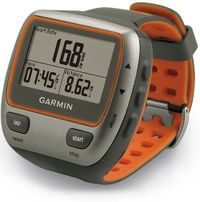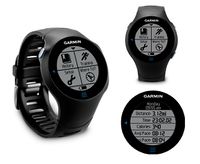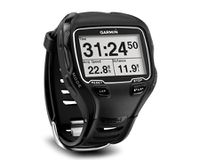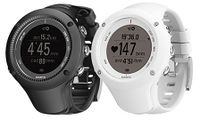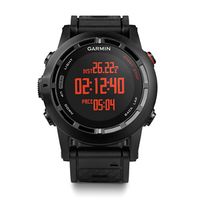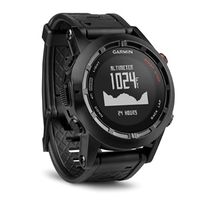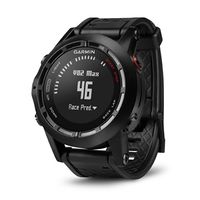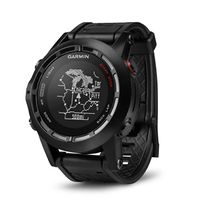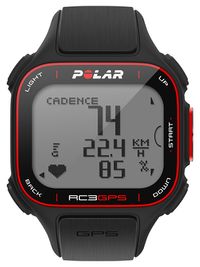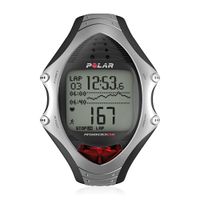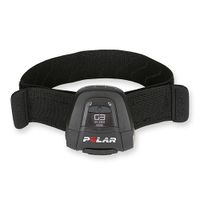Best Running Watch
This article is a concise guide to the best running watches available today at differing prices and functionality. As well as recommendations for the best watch, I also have a few that are worth considering in spite of their flaws, and some to avoid. For most runners my top choice is the Garmin 310XT, which is great value for money and has all the features you're likely to need. If that's too big and you want something more watch like, then the Garmin 610 is great, and it's often available refurbished at a great price.
| Watch | Recommendation Reason | With Heart Rate Monitor | Without Heart Rate Monitor | Accessory Heart Rate Monitor | Footpod |
|---|---|---|---|---|---|
| Garmin 310XT | The best value for money. | Error: Could not parse data from Amazon! | Error: Could not parse data from Amazon! | <jfs id="B0029M3NSS" n="Garmin HRM"> | Error: Could not parse data from Amazon! |
| Garmin 610 | Smaller than the 310XT/910XT recommendations. | Error: Could not parse data from Amazon! | Error: Could not parse data from Amazon! | <jfs id="B0029M3NSS" n="Garmin HRM"> | Error: Could not parse data from Amazon! |
| Garmin 910XT | A better but more expensive version of the 310XT. | Error: Could not parse data from Amazon! ($50 Rebate until July 31, 2014) |
Error: Could not parse data from Amazon! ($50 Rebate until July 31, 2014) |
<jfs id="B0029M3NSS" n="Garmin HRM"> | Error: Could not parse data from Amazon! |
| Suunto Ambit2 R | A good watch at a reasonable price, with only one flaw. | Error: Could not parse data from Amazon! | Error: Could not parse data from Amazon! | <jfs id="B0029M3NSS" n="Garmin HRM"> (buy the Garmin, not the Suunto) | |
| Garmin Fenix 2 | The most features, but pricy and patchy GPS accuracy. | Error: Could not parse data from Amazon! | Error: Could not parse data from Amazon! | <jfs id="B00FK7YS10" n="Garmin HRM-Run"> | |
| Motorloa Motoactv | If you can live with the flaws, it's brilliant. (Discontinued, so only buy if it's under $150). |
Not available as a package | Error: Could not parse data from Amazon! | <jfs id="B0029M3NSS" n="Garmin HRM"> | Error: Could not parse data from Amazon! |
| Polar RC3 GPS | Better Heart Rate Monitoring than Garmin. | Error: Could not parse data from Amazon! | Error: Could not parse data from Amazon! | ||
| Polar RS800CX | If you need Heart Rate Variability displayed and recorded. (You probably don't.) |
Error: Could not parse data from Amazon! | Not available | ||
| Soleus 1.0 | Remarkably cheap, but limited. | Not supported | Error: Could not parse data from Amazon! | Not supported | Not supported |
| Garmin 620 | Nice features, but appalling GPS Accuracy. | Error: Could not parse data from Amazon! | Error: Could not parse data from Amazon! (But you need the HRM for many of the features.) |
<jfs id="B00FK7YS10" n="Garmin HRM-Run"> | Error: Could not parse data from Amazon! |
| Garmin 10 | Small and cheap, but appalling GPS Accuracy and there are better watches for not much more. |
Not supported | Error: Could not parse data from Amazon! | Not supported | Not supported |
1 What to look for
There are several features to consider when looking for a runners watch.Contents
- 1 What to look for
- 2 Recommended
- 3 Worth Considering
- 4 Buyer Beware
- 5 Not Recommended
- 6 Using a Smartphone
- GPS. GPS provides an easy measure of how far you've run, which is critical for your training. While it is possible to map out a run afterwards, this tends to be tedious and is typically less accurate than GPS. However, GPS is not accurate enough to display your current pace. The Garmin 910XT, 310XT and 610 can display current pace from the Foodpod while using GPS for distance.
- GPS Accuracy. I've Analyzed the Accuracy of GPS watches, and I've found that there are wide differences in accuracy. The Garmin 620 and Garmin 10 are especially poor. Interestingly, adding a Footpod to the 310XT improves their accuracy noticeably. I've not tested all the watches yet, but more devices will be added as time allows. (My testing methodology requires me to run 100s of miles with each watch.)
- Weight. None of these devices weigh enough to have a noticeable impact on running performance, but the weight can be noticeable.
- Size. The size of these devices varies widely, and the larger devices can feel a little bulky, especially if you have a smaller wrist. I've provided the size as the volume in cubic centimeters to give a single number to compare.
- Waterproofing. Even if you don't swim, having good waterproofing is important to prevent your watch being destroyed by the rain or sweat.
- Current pace from a Footpod. A Footpod can be used to provide pace and distance. Displaying pace from the Footpod provides a far more accurate indication of current pace than GPS, which is important for any training program that requires running at a specific pace. Unlike GPS, Footpods need to be calibrated to provide accurate pace/distance, but this is relatively easy. For most runners, once the Footpod is calibrated it will display the right pace across a wide range of paces.
- Heart Rate Monitor. Heart Rate is important information when training, though it is important to understand the limitations of heart rate based training. Having a Heart Rate Monitor that will record your heart rate is particularly valuable for evaluating your training.
- Note that the Heart Rate Monitoring of Garmin watches is not as reliable as the Polar systems, but there are things to can do to improve the Garmin HRM issues.
- Cadence. A display of Cadence is a critical training tool and newer watches are able to use an internal accelerometer to provide Cadence without any accessories. Other watches may need a Foodpod.
- Data Upload. The ability to record your workout and store it in a training log such as Dailymile or SportTracks is vital. All of the recommended watches here have that ability. I'd strongly advise even a new runner to store their data so that they can look back over the months and years to understand their progress. A watch that can upload to a PC makes recording your workouts much easier.
- Battery Life. How much battery life you need depends on how long you run for. It's best to have a watch that will last quite a bit longer than your longest run.
- Altimeter. An altimeter will measure the atmospheric pressure and give you altitude. This is more accurate than GPS, but will require calibration to adjust for weather related pressure changes.
- Navigation. The primary purpose of GPS in these devices is to measure distance, but some of them can also provide navigation. This navigation varies from a simple compass needle showing the direction to return to the start to a display of the route you've just run or a preloaded course. The Motoactv and Fenix 2 can display preloaded maps showing roads and names.
- Training Effect. This is a measure of how hard a training run is as a numeric value of 1.0 to 5.0, based on an analysis of Heart Rate Variability.
- Heart Rate Variability. There is a growing interest in the possibility of using Heart Rate Variability (HRV) to evaluate training stress. While only one device will display HRV, there are several that will record HRV for later analysis.
Here's a table of these features for each of the watches I recommend (all have GPS).
| Watch | GPS Accuracy | Weight (oz) | Size (CM3) | Waterproofing | Pace from FootPod | Heart Rate Monitor | Cadence | Data Upload | Battery Life | Altimeter | Navigation | Training Effect | Heart Rate Variability |
|---|---|---|---|---|---|---|---|---|---|---|---|---|---|
| Garmin 310XT | 5.9 (6.6 with Footpod) | 2.5 | 63 | Good (50m) | Yes | Yes | Footpod | Yes | Good (20hr) | No | Map of current route | No | No |
| Garmin 610 | 6.4 | 2.5 | 41 | Fair (IPX7) | Yes | Yes | Footpod | Yes | Fair (8hr) | No | Back to start | Yes | Record only |
| Garmin 910XT | 6.8 with Footpod | 2.5 | 49 | Good (50m) | Yes | Yes | Footpod | Yes | Good (20hr) | Yes | Map of current route | Yes | Record only |
| Suunto Ambit2 R | 5.8 | 2.5 | 30 | Good (50m) | No | Yes | Internal | Limited | Fair (8 Hr, more in extended mode) | No | Back to start map | Yes | Record only |
| Garmin Fenix 2 | 3.8 | 3.2 | 32 | Good (50m) | No | Yes | Internal | Yes | Good (15Hr, more in extended mode) | Yes | Map of current route | Yes | No |
| Motorloa Motoactv | 1.2 | 20 | Poor (IPX7 with seals in place) | No | Yes | Footpod | Limited | Poor (3-6hr) | No | Full color maps | No | No | |
| Polar RC3 GPS | 5.1 | 2.0 | 29 | Poor (IPX7 with seals in place) | No | Yes | Footpod | Yes (but painful) | Fair (13hr) | No | No | No | No |
| Polar RS800CX | 3.5 | 48 | Good (50m) | Yes | Yes | Footpod | Yes | Months! | Yes | No | No | Record and Display | |
| Soleus 1.0 | 2.0 | 28 | Good (30m) | No | No | No | No | Fair (8hr) | No | No | No | No | |
| Garmin 620 | 3.9 | 1.5 | 20 | Good (50m) | Yes | Internal | Yes | Fair (10hr) | No | No | Yes | Record only | |
| Garmin 10 | 4.1 | 1.3 | 33 | Good (50m) | No | No | No | Yes | Poor (5hr) | No | No | No | No |
2 Recommended
This section covers the watches I'd recommend as 'the best'. Which one is the best for you depends on your budget and requirements.
2.1 The best value - Garmin 310XT
The best value watch for most runners is currently the Garmin 310XT. It is available with a Heart Rate Monitor for around $50 more. The Garmin 910XT is better, but not worth the extra cost for most runners.
2.1.1 Garmin 310XT Pros
- The 310XT is great value for money at this price level.
- The 310XT is a sophisticated sports watch, but is no harder for a beginner to use than most alternatives. In fact, its size and physical buttons make it relatively easy to use, especially when compared to the 4xx series Garmin watches.
- A great feature is the ability to use the optional Footpod to display your current pace while using GPS for overall pace, distance and route. Only the 310XT, 910XT and Garmin 610 can do this.
- The 310XT has good GPS accuracy. When it starts up in the same location as the last run it will acquire satellites quickly.The GPS is more accurate than earlier watches, and has a faster startup time. The optional Footpod also improves GPS accuracy.
- The housing is fully waterproof (to 50m/160ft), so Running in the Rain is no problem.
- The display is big enough to show four readings. I often display current pace, average pace for the current lap, average pace for the run and either heart rate or distance.
- You can upload courses and display them. This is great when running somewhere unfamiliar.
- There are several optional extras for the 310XT, including the already mentioned Footpod and heart rate strap. For cyclists there is also a speed/cadence sensor and it works with various power sensors.
2.1.2 Garmin 310XT Cons
- Some people find the 310XT to be rather large, and it is much larger than a normal watch.
- The battery life is good for about 16-20 hours, which is enough for most people. Ultrarunners doing 100 mile or longer races will find this a problem, though it is possible to recharge it while in use.
- For races where the GPS track is not important, you can extend the battery life by turning off the GPS receiver and use the Footpod. After 24 hours of running I still have most of the battery left. If you're running on a reasonable smooth surface, the Footpod is often more accurate than GPS.
2.2 Smaller – Garmin 610
The Garmin 610 is smaller than most of the available watches and overcomes many of the issues seen in the 4xx range (see below). With the release of the 620 the price of the 610 has started falling, so it has become better value. While the 620 has many more features than the 610, the 610 is actually a better watch as it has good GPS Accuracy and can display pace from a Footpod.
2.2.1 Garmin 610 Pros
- The 610 is smaller than the 910XT/310XT and closer to the size of a traditional watch.
- Like the 310XT, it can use the optional Footpod to display your current pace while using GPS for overall pace, distance and route. Only the 310XT, 910XT and 610 can do this (so far).
- The 610 displays and records Training Effect, an indicator of how hard or effective a training session is. I don't think the algorithm in the 610 is quite as good as the 620, it's still useful.
- The touchscreen interface works with gloves and in the rain, unlike most touchscreens found on phones or media players.
- The 610 will not display Heart Rate Variability but it is possible for it to record Heart Rate Variability for later analysis. This recording can be enabled from the firstbeat.com ATHELTE software (there's a free trial).
2.2.2 Garmin 610 Cons
- The battery life is rather short. It is claimed to provide 8 hours, but based on experience with other Garmin devices, the actual live may be quite a bit less. This is likely to cause an issue for slower marathon runners or ultrarunners.
- Not the range of accessories that the 910XT/310XT has, such as power meter for cycling.
- No display of course maps or mapping of your current route, but it has a simplistic 'back to start' arrow.
2.3 The solid choice - Garmin 910XT
The Garmin 910XT is a version of the 310XT with extra features, but it's more expensive. Probably the most useful feature for most runners is the calculation of Training Effect. It can also record laps when swimming, is better at recording altitude, and can record Heart Rate Variability. If you can afford the 910XT, then it's a little better than the 310XT, but the 310XT is better value. (The 910XT is available with the Heart Rate Monitor as Error: Could not parse data from Amazon!.) At this price point, compare the 910XT with the Fenix 2.
2.3.1 Garmin 910XT Pros
- The pros of the 310XT also apply here.
- The 910XT displays and records Training Effect, an indicator of how hard or effective a training session is.
- The 910XT can record swimming, but it does this with an accelerometer rather than GPS. You have to tell the 910XT how long the pool is, but it will detect each lap, as well as your stroke.
- The 910XT has a barometric altimeter, which is far more accurate at recording altitude changes than GPS.
- The 910XT will not display Heart Rate Variability but it is possible for it to record Heart Rate Variability for later analysis. This recording can be enabled from the firstbeat.com ATHELTE software (there's a free trial).
2.3.2 Garmin 910XT Cons
- The cons of the 310XT also apply here.
- The biggest downside for most people over the 310XT is the price, which is significantly more than the 310XT.
2.4 Suunto Ambit2 R
The "R" in the name is for "Runner" and is the moniker for the cheapest of the Ambit2 range. It lacks some of the features of the more expensive Ambit2 watches, but the price is far more attractive. The Ambit2 R offers great functionality and reasonable GPS accuracy, and it's only significant flaw is the inability to display pace from a Footpod.
2.4.1 Ambit2 R Pros
- The watch is highly configurable, and configuration is via a web site rather than fiddling with the watch. The Ambit2 can display up to 8 different pages of data, including various graphs.
- You can download or create 'Apps' for the Ambit2, which allow for some degree of extensibility. These are not really applications, but small scripts so the functionality is rather limited.
- Data has to be uploaded to the Suunto website movescount.com but it can then be exported in many different formats including TCX and FIT.
- While the standard battery life is not great at 8 hours, you can configure the Ambit2 so it only checks GPS data periodically, which compromises GPS Accuracy but improves battery life. I found that after 20 hours of use with 1 minute GPS checks I had a claimed 61% of battery life left, giving a projected life of about 50 hours.
- The Ambit2 will download a list of GPS satellites for quicker GPS acquisition. This seems to work well, and when the cache is stale because the watch has not been connected to the internet for a while, GPS acquisition is still reasonable.
- The Abmit2 displays Training Effect, but unlike the Garmin units you have to explicitly set your 'activity class' rather than have the watch work it out automatically. In many ways I prefer having the activity class set explicitly. There is also support for "recovery time", though it's less obvious than the Garmin implementations which display the value at the end of each workout. The recovery time also resets with each workout rather than being a cumulative time, which limits its usefulness.
- The Suunto web site (movescount.com) has remarkably good analysis and data from the Ambit2.
- The "R" version of the Ambit2 is available in black or white, with the white version intended for women. I tried the white version as I have smaller wrists and I found the materials used for the strap are remarkably soft and comfortable.
- If you're prepared to pay more, you can get other versions of the Ambit2 that provide extra functions. (There's also a Sapphire version that's more expensive but functionally identical to the Ambit2.)
| Ambit2 | Ambit2 S | Ambit2 R | |
|---|---|---|---|
| Price | $500 | $350 | $250 |
| Claimed battery life | Up to 50 hours | Up to 25 hours | Up to 25 hours |
| Barometric altimeter | Yes | No | No |
| Cycling support (speed/candence/power) | Yes | Yes | No |
| Swimming support | Yes | Yes | No |
2.4.2 Ambit2 R Cons
- The biggest downside to the Ambit2 compared to the 310XT/910XT/610 is that there is no way of displaying your current pace from the Footpod while using GPS for overall distance and course. You can only use a footpod by turning off GPS, which is pretty useless.
- Like any complex device, the Ambit2 can occasionally need a reboot. Sadly, while you can shut down the Ambit2 from the menu, the only way of waking it up again is to plug it into a USB power source. This should be a very rare issue, but if it happens to you on or just before a race, you're screwed.
- While the Ambit2 can display a map of a route, or give you a map for going back to the start, there is not a simple display of your current route.
3 Worth Considering
These watches are good, but they are not quite good enough to be completely recommended.
3.1 The most features - Garmin Fenix 2
The Fenix 2 combines the best features of the Garmin 910XT and 620, plus some extras and is the best running watch at the moment. This is a remarkable watch, with a vast array of features, but remains reasonably easy to use. The only flaws are the lack of current pace from a Footpod and the disappointing results of my GPS Accuracy testing.
3.1.1 Fenix 2 Pros
- When combined with the new heart rate monitor strap, the Fenix 2 will show and record Cadence, Vertical Oscillation (VO) and Ground Contact Time (GCT). This is fascinating data, but it's not clear how to interpret and use VO or GCT. This confusion is compounded by the way that a higher Cadence will result in a lower VO and lower GCT simply because of the faster turnover. The Fenix 2 has a display of Cadence, VO, and GCT that gives an indication of how good your current values are, but without the color display of the Garmin 620 this indicator is not as clear. The Fenix 2 can also display Cadence using the internal accelerometer.
- Like several other devices, the Fenix 2 displays Training Effect, an indicator of how hard or effective a training session is. In my unscientific trails, the Training Effect on the Fenix 2 seems similar to the 620, which is a change from the 610/910XT.
- The Fenix 2 builds on the Training Effect to give an estimation of the recovery time before the next workout. While this is only an estimation and there are no studies that evaluate it, there is the possibility that it might help prevent Overtraining. There is also a display of your recovery after the first mile or so of each run, which is again a nice idea. Sadly, if you miss the message, there does not appear to be a way of recalling it, nor does the Fenix 2 record this value.
- The Fenix 2 will cache the locations of the GPS satellites for the next few days, which will reduce the satellite acquisition time when travelling to a new location. In my usage the satellite acquisition was very rapid when cached, but if I'd not connected it for a while, it could be painfully slow to acquire a lock.
- The Fenix 2 has 5 well positioned buttons that I find much easier to use than even the best touch screen.
- As well as GPS, the Fenix 2 includes a barometric altimeter, which is far more accurate than GPS for altitude. It also includes a thermometer, and while the watch is too close to your skin for accuracy it does give a good general indication.
- For displays of Heart Rate, Altitude, Barometric pressure and Temperature you can also get a small graph that shows changes over time. I've enjoyed this feature.
- There is a prediction of your V̇O2max, which worked well for me, but I would not rely on its accuracy.
- The Fenix 2 is large, but not as big as the 310XT or 910XT and it looks like a watch rather than a dive computer. .
- There is good navigation displays, with options for waypoints and courses. The Fenix 2 can have uploaded maps.
- The battery life is claimed to be 15 hours with normal recording, but I found that 11 hours is more likely. It has options to extend the battery life up to a claimed 50 hours (I've not yet tested the extended mode yet.)
- There is an option only to have the backlight turned on when the sun is down, which is another small, but useful feature. The backlight is also red colored, which prevents the watch from blinding you at night.
- The Fenix 2 will link to a smart phone to upload a workout as it takes place, which is nice for folks tracking you during a race, though it means wearing the watch and the phone together.
- You can add as many pages of displays as you want, which given how much the Fenix 2 can tell you, is great.
3.1.2 Fenix 2 Cons
- The biggest downside to the Fenix 2 compared to the 310XT/910XT/610 is that there is no way of displaying your current pace from the Footpod while using GPS for overall distance and course. You can configure it to get both pace and distance from the Footpod, but that's not an ideal solution.
- My initial testing for GPS accuracy is a little disappointing, though it's much better than the appalling accuracy of the 620 and 10.
- The Fenix 2 includes an internal accelerometer to give you an idea of pace and distance while running on a treadmill without a footpod. I found it was too far out to be of any use, giving a display that was off by 1-3 minutes/mile. A lot will depend on your running style and how you use a treadmill.
- You need to have the new "HRM Run" for the running dynamics features. It will display Heart Rate and calculate Training Effect with the older Garmin HRM, but not Ground Contact Time or Vertical Oscillation.
3.2 Brilliant, but flawed – Motorola Motoactv
The discontinued Motorloa Motoactv was a revolutionary running watch, using a color touch screen, GPS and including an MP3 player. It was more like a smartphone than a traditional GPS watch; the Motoactv was brilliant, but it was also flawed. When it was originally introduced at $250, these flaws were too severe for it to compete with the Garmin alternatives. The price of the Motoactv tends to vary, but it is often available for under $150, and at that price the Motoactv is great value for money. If you can live with each of these four flaws, then the Motoactv is a great buy. (See the cons section for more details on each.)
- Poor water resistance. Don't buy the Motoactv is you want to swim or if you're likely to forget to check the covers before your run.
- Limited battery life. If you run for less than 3 hours, you're fine with the Motoactv. If you run for between 3 and 6 hours then think carefully. If you run for more than 6 hours, look elsewhere.
- No usable 'current pace' display. Don't try to use the Motoactv to keep you on pace. (This is true of all GPS watches unless you can display the pace from a Footpod.)
- 'Difficulty uploading workouts to a training log.' If you want to keep an automated training log (and you should), the Motoactv will be hard work.
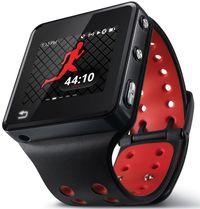 The Motorloa Motoactv with the watch strap (it's available as with a clip instead). |
3.2.1 Motoactv Pros
- With the recent price reduction the Motoactv is less than $150, which is far cheaper than any comparable product.
- The Motoactv is easy to use, and my family prefers using the Motoactv over Garmin products.
- The color display is nice, and the simple monochrome display of other devices seems stale and dated by comparison.
- The combination of a touch screen and physical buttons works quite well. The screen works when wet, though I found some occasional problems when there was just a drop of sweat rather than a soaking. I also found that heavy rain drops may act as screen presses, which is annoying.
- I love having a continually lit display for Running in the Dark. You can press a button on a Garmin to illuminate the display, but the Motoactv is much better.
- The inclusion of an MP3 player is nice, and it claims to learn what songs make your run harder. Personally I prefer using a separate MP3 player, but having the one device that does both has some appeal.
- The Motoactv will display a true map of the area, showing the street layout, which is a huge improvement over the breadcrumb display of the Garmin watches. If you could upload a route then this would be great for running in a new city.
- The dimensions of the Motoactv are more pleasing than the Garmin 310XT/910XT. It still has a large display, but it is much thinner.
3.2.2 Motoactv Cons
- The Motorloa Motoactv is discontinued, but still available.
- The Motoactv is 'water resistant' not waterproof. There are many reports of water damage and Motorola refusing to repair them. However, there are also many reports of using the Motoactv in torrential rain, which I've done myself. I suspect the issue is that the Motoactv has small covers for the headphone jack and the USB port, and if they are not in place, water can get in and destroy the watch.
- The battery life of the Motoactv is quite poor compared with other devices. If you use Bluetooth headphones and use the default setting the battery is dead in 3 hours. With no Bluetooth and the 'extended battery' setting it should last for 6 hours. This is probably plenty for most runners, but you have to remember to keep it plugged in, as the battery seems to drain faster than I would expect.
- Like any GPS watch, the display of your current pace varies too much to be of any use. This is an intrinsic problem with GPS, and I found the Motoactv was out by up to a minute/mile. This is why I recommend the Garmin 310XT/910XT/610 as they can display your current pace from the Footpod while still using the GPS for everything else. You can use the 'lap average pace' to get a reasonable idea of your pace, but if you need to hit a specific pace for a training run or a race, you're better off with one of the Garmin 310XT/910XT/610 and a Footpod.
- The Motoactv will upload your workout to Motoactv.com via a wireless network, so you don't even need a PC, which is a great idea. The problem is that it's hard to upload your workouts to any other training log. You can download each workout as a CSV file and upload it to another tool, but that sometimes requires going via a conversion program.
- The Motoactv will support a Footpod, including the Error: Could not parse data from Amazon!, and it can use the FootPod to show your pace/distance. This only works if you select to run outdoors, which turns the GPS off. The bigger problem is that there is no way of calibrating the Foodpod, so there is usually an error (for me it was out by 7%). The Motoactv does have an internal sensor that can be calibrated, but this does not work for the FoodPod. The Motoactv will use the FootPod to display your Cadence, but I found the Cadence display to vary widely; my Garmin would show a steady cadence value when the Motoactv was swinging widely.
3.3 Better Heart Rate Monitoring – Polar RC3 GPS
The Polar RC3 GPS is Polar's first sports watch that has an integrated GPS, rather than requiring a separate box. In many ways, it's quite nice unit, but it's not quite as good as the cheaper Garmin 310XT.
3.3.1 Polar RC3 GPS Pros
- Over the years I found the quality of Polar accessories to be much higher than Garmin. I've never had a Polar accessory fail on me, but I'm currently on my fourth chest transmitter and my third Footpod.
- I've had a few issues with the accuracy and reliability of the Polar Heart Rate Monitoring, but I've had to create a page dedicated to solving issues with Garmin Heart Rate Monitoring.
- It's available in several colors.
3.3.2 Polar RC3 GPS Cons
- The biggest flaw in the RC3 GPS is that it's not quite as good as the cheaper Garmin 310XT.
- It's much harder to get your data from a Polar device to the various training software that's available. Often you have to convert the files from the Polar format to TCX, and the best tool I've found is [TcxCreator].
- It's only waterproof to IPX7, which 3'/1m for 30 minutes. It might be showerproof, but not much more than that.
3.4 If you need Heart Rate Variability – Polar RS800CX
The Polar RS800CX is becoming something of a specialist device. Its claim to fame is that it can display Heart Rate Variability, and as far as I know, this is the only device that will do this, though some of the Garmin devices will record HRV for later analysis. Even the new RCX5 does not support this feature.
3.4.1 RS800CX Pros
- Heart rate monitoring is far better than with Garmin. The RS800CX will even record each individual heart beat for analyzing Heart Rate Variability, though few people will ever make use of that feature.
- The battery life of the RS800CX is measured in months not hours. This should not be an issue for most runners.
- The RS800CX is the size of a conventional watch, and because of the long battery life, it can be used as one.
- Includes a barometer for altitude (GPS has very poor accuracy for altitude).
- There is a Polar Footpod, the Polar S3+ Stride Sensor, which works nearly as well as the Garmin equivalent, but it's larger and more expensive.
- Fully waterproof.
3.4.2 RS800CX Cons
- It's Expensive at around $290.
- While the RS800CX can support GPS, it requires an add-on GPS box you strap to your arm, which is a rather poor solution. The GPS has a battery life of only 20 hours and requires recharging.
- There is no display of course maps.
- This is a Heart Rate Monitor and it objects if you try to use it without the monitor.
3.5 The Cheapest – Soleus 1.0
The Soleus 1.0 is one of the cheapest on the market, with a recommended price of $99, but often available from Amazon for $75-85. While it has some significant limitations, it is basically functional. The Garmin 10 is the cheapest Garmin GPS watch, but at $130 it's nearly twice the price of the Soleus 1.0. (There are other GPS watches by Soleus that have better functionality, but their price makes them unattractive when compared with the other watches here.)
3.5.1 Soleus 1.0 Pros
- The big attraction of the Soleus 1.0 is the price, which is half that of the next cheapest watch I'd recommend (the Garmin 10).
- This is a smaller watch, similar in size to the Garmin 610.
3.5.2 Soleus 1.0 Cons
- There is no upload of data to a PC (which also means no firmware updates).
- No support for a Heart Rate Monitor or a Footpod.
- The claimed battery life is 8 hours, which is a little short. However, I've read reports of people getting longer battery life.
- The initial acquisition of the GPS satellites is slower than the better watches like the 310XT/910XT.
4 Buyer Beware
These devices are sufficiently flawed to make them impossible to recommend.
4.1 Small, advanced, but poor accuracy- Garmin 620
The Garmin 620 is an intriguing device, adding some cool advanced features but it has appalling GPS accuracy that prevents me recommending it. This is a real shame as other than the accuracy problems I love using the 620. However, I've had the 620 record only 12 miles on a 13 mile run, something that I consider unacceptable.
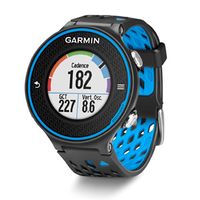
4.1.1 Garmin 620 Pros
- The 620 is small and light, but the display is quite legible for its size. I find it much easier to read than either the 610 or the 10.
- Like the Fenix 2, the 620 will show and record Cadence, Vertical Oscillation (VO) and Ground Contact Time (GCT). The 620 has a nice display of Cadence, VO, and GCT that gives a color coded indication of how well you're doing.
- Like several other devices, the 620 displays Training Effect, an indicator of how hard or effective a training session is.
- The 620 includes an estimation of the recovery time before the next workout, just like the Fenix 2.
- The 620 will cache the locations of the GPS satellites for the next few days, which will reduce the satellite acquisition time when travelling to a new location. In my usage the satellite acquisition was very rapid.
- The touchscreen works better than any other I've tried while running.
- There is a prediction of your V̇O2max, which worked well for me, but I would not rely on its accuracy.
- The 620 will upload your workouts to Garmin Connect via WiFi without needing a computer. It will also link to a smart phone to upload a workout as it takes place, which is nice for folks tracking you during a race, though it means wearing the watch and the phone together.
- The 620 will not display Heart Rate Variability but it is possible for it to record Heart Rate Variability for later analysis. To enable this recording, you need to download a special FIT file from the firstbeat.com web site.
4.1.2 Garmin 620 Cons
- The GPS Accuracy of the 620 is grim. I found the 620 consistently worse than the 610 or the 310XT when I ran with multiple devices. The 620 would sometimes be over a mile out on a 13 mile run!
- To make the poor GPS accuracy even more annoying, there is no way of displaying your current pace from the Footpod while using GPS for overall distance and course. (Earlier versions of the firmware would always display the pace and distance from the Footpod when it's connected, but this was fixed in a recent update.)
- The 620 includes an internal accelerometer to give you an idea of pace and distance while running on a treadmill without a footpod. While firmware updates have improved the accuracy, I found it was too far out to be of any use, giving a display that was off by 1-3 minutes/mile. A lot will depend on your running style and how you use a treadmill.
- There is no map display or navigation, but on a device this small it would be hard to make that useful anyway.
- The battery life is a little short for ultramarathons, but it is fine for the most runners.
- You need to have the new HRM for the new features. It will display Heart Rate and calculate Training Effect with the older Garmin HRM, but not Ground Contact Time or Vertical Oscillation.
4.2 Simple - Garmin 10
The Garmin 10 is a simpler watch than most, with only a few functions, which makes it good for the technophobe. However, the GPS Accuracy of the 10 is grim, which prevents it being worth considering, even at this price. The 10 is the cheapest GPS enabled watch that Garmin makes, and price wise it fits between the cheaper Soleus 1.0 and the slightly more expensive Garmin 310XT. I think it's worth the extra $30 over the Soleus 1.0 for the ability to download data and automatically maintain your training log. However, the price of the Garmin 310XT has been steadily falling, and I believe the upgrade is well worth the price difference if you can afford it and don't mind a larger watch.
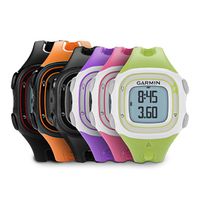
4.2.1 Garmin 10 Pros
- Cheapest Garmin GPS watch.
- Smaller than the 910XT/310XT and closer to the size of a traditional watch.
- Available in two sizes with either a 2.5cm or a 2.1cm screen, as well as several colors.
- The limited functionality makes it easy to use.
4.2.2 Garmin 10 Cons
- The GPS Accuracy of the 10 is truly awful, and is even worse than the 620.
- The battery life is rather short. It is claimed to provide 5 hours, and this is likely to cause an issue for slower marathon runners or ultrarunners.
- Not the range of accessories that the 910XT/310XT has, such as Heart Rate Monitor or Footpod.
- No display of maps or other navigation.
5 Not Recommended
These watches have flaws or a price point that makes them unattractive.
5.1 Suunto Ambit/Ambit 2
The main attraction of the Suunto Ambit is its 50 hour battery life. However, to get the long battery life you have to select a mode which only takes a GPS fix every 60 seconds which gives poor accuracy. Other problems that prevent me from recommending it:
- Difficulty in upload the data to other software.
- No Footpod.
- The big advantage of GPS over a footpod is it will show you a map of where you've been and with the Garmin watches, you can upload a course to follow. The Ambit does not do that type of display.
- The price; at $500 there are better options available cheaper. For the same price you could buy two 310XTs, three MOTOACTVs, or five Soleus 1.0 watches.
5.2 Garmin Fenix
Like the Suunto Ambit, the $400 Garmin Fenix claims a 50 hour battery life. However, there are reports that the battery life is much shorter in practice. However, the new Garmin Fenix 2 is a cracking good watch.
5.3 Garmin 405/405CX/410
The Garmin 4xx series watches use a touch sensitive bezel which does not work well with gloves or when wet. The Garmin 410 has an 'improved bezel', but there are still problems. I also see more people struggling at the start of marathons with the 4xx watches than all the other devices combined.
5.4 Nike+ Sportwatch
There is a lot to like about the Nike+ Sportwatch, but it has one weakness that I believe is unacceptable. The software for the Nike+ does not allow you to use the data from your runs in anything other than the Nike web site. A training log is important, and while beginners may not need one, buying a watch that prevents you from accessing your data in the future is too limiting. The Motoactv is a far more capable watch than the Nike+, though it too has some flaws.
5.5 Garmin 305/205
The 305/205 are the earlier generations of Garmin GPS watches, and are getting hard to find. With the price drops of other devices these Garmin watches no longer offer reasonable value for money.
6 Using a Smartphone
Most smartphones have a GPS built in and support various applications that allow them to function as sports watches.
6.1 Smartphone Pros
- If you already have a smartphone, this is the cheapest option.
- Carrying a phone allows you to call for help.
- You may be able to use the smartphone as an MP3 player.
- It is possible to use a Heart Rate Monitor or even a Footpod with a smartphone.
- The Polar H7 heart rate monitor works with iPhone 4S/5 for $63. This will work with Runkeeper, Mapmyrun(+), EndoMondo (Pro), Runmeter, and others. (Android phones not supported.)
- The Wahoo Key is a $55 dongle that adds Ant+ support to an iPhone 4S/4/3GS. This allows you to use the <jfs id="B0029M3NSS" n="Garmin HRM">, Error: Could not parse data from Amazon! and other Ant+ accessories. It works with most apps including RunKeeper, MapMyRun(+), EndoMondo (Pro), Runmeter. Note that the dongle may cause problems finding a waterproof case.
- The Garmin Ant+ Adapter is similar to the Wahoo Key but it has limited app support.
- The Zepher HxM is a $79 (+shipping) heart rate monitor that works with Android and Blackberry phones.
- Some [Sony Ericsson android phones] have Ant+ support built in.
6.2 Smartphone Cons
- A smartphone is usually bulky and has to be mounted on your upper arm, making it hard to see the display.
- A smartphone mounted on your arm makes you a potential target for theft, reducing your safety.
- Most touchscreens do not work well with gloves, in the rain, or with sweaty hands.
- Few smartphones are waterproof, so a specialist case will be required to protect it.
